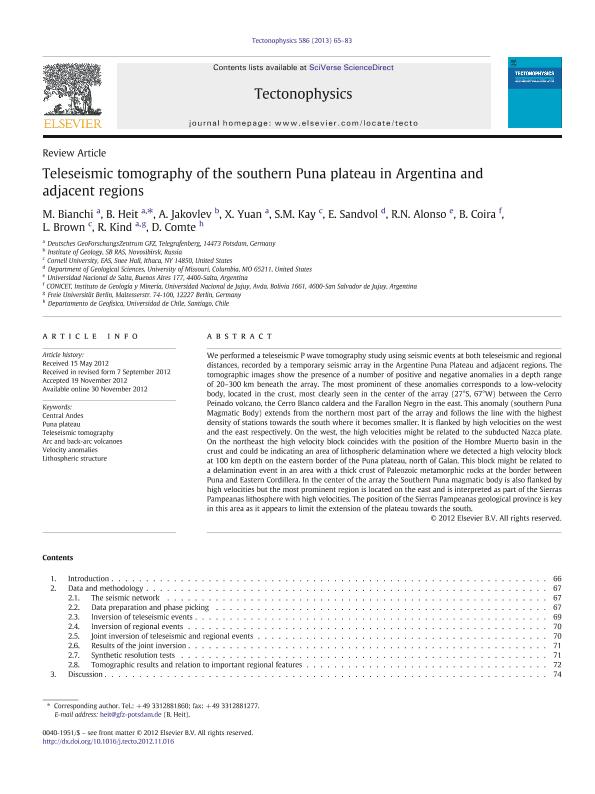Mostrar el registro sencillo del ítem
dc.contributor.author
Bianchi, M.
dc.contributor.author
Heit, B.
dc.contributor.author
Jakovlev, A.
dc.contributor.author
Yuan, X.
dc.contributor.author
Kay, S. M.
dc.contributor.author
Sandvol, E.
dc.contributor.author
Alonso, Ricardo Narciso

dc.contributor.author
Coira, Beatriz Lidia Luisa

dc.contributor.author
Brown, L.
dc.contributor.author
Kind, R.
dc.contributor.author
Comte, D.
dc.date.available
2016-08-29T17:09:29Z
dc.date.issued
2013-02
dc.identifier.citation
Bianchi, M.; Heit, B.; Jakovlev, A.; Yuan, X.; Kay, S. M.; et al.; Teleseismic tomography of the southern Puna plateau in Argentina and adjacent regions; Elsevier Science; Tectonophysics; 586; 2-2013; 65-83
dc.identifier.issn
0040-1951
dc.identifier.uri
http://hdl.handle.net/11336/7332
dc.description.abstract
An array of 74 seismological stations was deployed in the Argentine Puna and adjacent regions for a period of two years. The aim is to investigate the seismic structure in the crust and upper mantle in order to address fundamental questions regarding the processes that form, modify and destroy continental lithosphere and control lithospheric dynamics in this part of the Central Andes. This portion of the Central Andes is an ideal locale to address these questions given that there is geologic evidence that there has been recent lower crustal and mantle lithospheric delamination. We performed a teleseismic P wave tomography study using seismic events at both teleseismic and regional distances. The tomographic images show the presence of a number of positive and negative anomalies in this region. The most prominent of these anomalies corresponds to a lowvelocity body, located in the crust, in the center of the array (approximately at 27°S, 67°W) between the Cerro Peinado volcano, the Cerro Blanco caldera and the Farallon Negro in the east. This anomaly (southern Puna Magmatic Body) is flanked by high velocities on the west and the east respectively. On the west, this high velocity block might be related to the subducted Nazca plate. On the east, it coincides with the position of the Hombre Muerto basin in the crust and could be indicating an area of lithopheric delamination where we detected a high velocity block at 100 km depth on the eastern border of the Puna plateau. This block might be related to a delamination event in an area with a thick crust of Paleozoic metamorphic rocks from the Eastern Cordillera. We observed lower velocities in the Puna lithosphere that could be indicative of magma chambers derived from the ascent of fluids and melts from the top of the subducted plate probably induced by delamination. Beneath the oceanic Nazca plate, a low-velocity zone can be observed at depths greater than 200 km. The origin of this low velocity anomaly remains unclear but it could be caused by portions of asthenospheric material in the uppermost mantle. The position of this low velocity zone is in agreement with previous observations in the same area that have suggested the presence of a hot asthenospheric mantle upwelling induced by slab flattening. Keywords: Central Andes, Puna plateau, teleseismic tomography, arc and back-arc volcanoes, velocity anomalies, lithospheric structure.
dc.format
application/pdf
dc.language.iso
eng
dc.publisher
Elsevier Science

dc.rights
info:eu-repo/semantics/openAccess
dc.rights.uri
https://creativecommons.org/licenses/by-nc-nd/2.5/ar/
dc.subject
Teleseismic
dc.subject
Tomography
dc.subject
Andes
dc.subject
Puna
dc.subject.classification
Geociencias multidisciplinaria

dc.subject.classification
Ciencias de la Tierra y relacionadas con el Medio Ambiente

dc.subject.classification
CIENCIAS NATURALES Y EXACTAS

dc.title
Teleseismic tomography of the southern Puna plateau in Argentina and adjacent regions
dc.type
info:eu-repo/semantics/article
dc.type
info:ar-repo/semantics/artículo
dc.type
info:eu-repo/semantics/publishedVersion
dc.date.updated
2016-08-11T13:57:50Z
dc.journal.volume
586
dc.journal.pagination
65-83
dc.journal.pais
Países Bajos

dc.journal.ciudad
Amsterdam
dc.description.fil
Fil: Bianchi, M.. Deutsches GeoForschungsZentrum; Alemania
dc.description.fil
Fil: Heit, B.. Deutsches GeoForschungsZentrum; Alemania
dc.description.fil
Fil: Jakovlev, A.. Institute of Geology; Rusia
dc.description.fil
Fil: Yuan, X.. Deutsches GeoForschungsZentrum; Alemania
dc.description.fil
Fil: Kay, S. M.. Cornell University; Estados Unidos
dc.description.fil
Fil: Sandvol, E.. University Of Missouri; Estados Unidos
dc.description.fil
Fil: Alonso, Ricardo Narciso. Universidad Nacional de Salta; Argentina
dc.description.fil
Fil: Coira, Beatriz Lidia Luisa. Consejo Nacional de Investigaciones Científicas y Técnicas; Argentina. Universidad Nacional de Jujuy. Instituto de Geología y Minería; Argentina
dc.description.fil
Fil: Brown, L.. Cornell University; Estados Unidos
dc.description.fil
Fil: Kind, R.. Deutsches GeoForschungsZentrum; Alemania
dc.description.fil
Fil: Comte, D.. Universidad de Chile; Chile
dc.journal.title
Tectonophysics

dc.relation.alternativeid
info:eu-repo/semantics/altIdentifier/url/http://www.sciencedirect.com/science/article/pii/S0040195112007433
dc.relation.alternativeid
info:eu-repo/semantics/altIdentifier/doi/http://dx.doi.org/10.1016/j.tecto.2012.11.016
Archivos asociados
